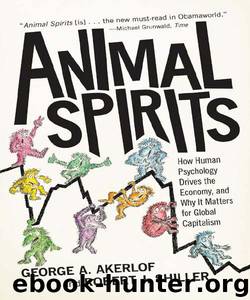Animal Spirits: How Human Psychology Drives the Economy, and Why It Matters for Global Capitalism by George A. Akerlof & Robert J. Shiller

Author:George A. Akerlof & Robert J. Shiller [Akerlof, George A. & Shiller, Robert J.]
Language: eng
Format: epub
Tags: Business & Economics, General, Economics, Macroeconomics, Theory, Finance
ISBN: 9780691145921
Google: 2Rz_cuu88DwC
Amazon: 069114592X
Publisher: Princeton University Press
Published: 2010-02-01T00:00:00+00:00
Going North
We need only go north to Canada to see a case in which Samuelson’s fears came true. Canada provides an instance in which denial of a tradeoff between inflation and unemployment not only mattered but mattered greatly. The U.S. economy was roaring in the 1990s. But up north our neighbors were experiencing the “Great Canadian Slump,” as it was named by the distinguished Canadian economist Pierre Fortin.17 In 1996 Fortin compared this slump to that seen in the Great Depression of the 1930s. His measure of the two recessions was the cumulative decline from peak of the employed fraction of the working-age population. As of 1996 the Canadian economy had already suffered 30% of the cumulative decline seen in the Great Depression.18 The Depression was not all that much worse, said Fortin in 1996. It had been deeper, and it had lasted longer. He could not have known then that it would take four more years for the economy to recover.
Where does Fortin place the blame? He makes a long list of all the possible causes of the recession, such as trade, fiscal policy, minimum wages, and restrictive monetary policy. He rapidly dismisses all of these but one: the restrictive monetary policy of the Bank of Canada. In 1987 the Canadians chose a new governor of their central bank, John Crow. Crow, born in London, had graduated from Oxford, worked at the International Monetary Fund for twelve years, and then transferred to the research department of the Bank of Canada. There he rose through the ranks: deputy chief of the research department, chief of the research department, adviser to the governor, and deputy governor. When Crow took over as governor, inflation was 4.8%. He took the bank’s mandate to maintain price stability seriously. Crow was a firm believer in both natural rate theory and the ability of the central bank to bring inflation down. And he was successful in this task. In 1993 inflation fell to 1.8%—but at a terrible cost.19 Unemployment reached levels not seen since the Great Depression. In 1992 it stood at 11.3%.20
Yet Crow was proud of what he had accomplished. In his view the costs of lowering inflation were temporary, but the benefits, because of the changed expectations, would be permanent. Crow defended his policies vigorously, to the point that the Canadian press described him as “combative” and “abrasive.”21 In 1994 he was replaced by Gordon Thiessen, who, in contrast, was unfailingly polite. But—true to his spots as a central banker who had learned his trade in the same Bank of Canada shop as Crow—Thiessen continued the very low inflation targets of the previous regime, for seven more years.
This story should serve as a warning. Too much faith is placed today in natural rate theory. For the past quarter century the United States has had a sensible monetary policy, which carefully balances the twin goals of price stability and full employment. But we are in great fear of ideologues on a future Federal Reserve Board
Download
This site does not store any files on its server. We only index and link to content provided by other sites. Please contact the content providers to delete copyright contents if any and email us, we'll remove relevant links or contents immediately.
The Secret History by Donna Tartt(16622)
The Social Justice Warrior Handbook by Lisa De Pasquale(11489)
Thirteen Reasons Why by Jay Asher(7788)
This Is How You Lose Her by Junot Diaz(5771)
Weapons of Math Destruction by Cathy O'Neil(5036)
Zero to One by Peter Thiel(4824)
The Myth of the Strong Leader by Archie Brown(4789)
Promise Me, Dad by Joe Biden(4447)
Beartown by Fredrik Backman(4417)
Stone's Rules by Roger Stone(4415)
How Democracies Die by Steven Levitsky & Daniel Ziblatt(4398)
The Fire Next Time by James Baldwin(4342)
100 Deadly Skills by Clint Emerson(4076)
A Higher Loyalty: Truth, Lies, and Leadership by James Comey(4032)
Rise and Kill First by Ronen Bergman(4012)
The David Icke Guide to the Global Conspiracy (and how to end it) by David Icke(3881)
The Farm by Tom Rob Smith(3872)
Secrecy World by Jake Bernstein(3782)
The Doomsday Machine by Daniel Ellsberg(3730)
